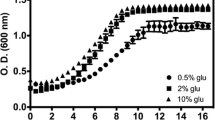Abstract
Calorie restriction is a dietary regimen capable of extending life span in a variety of multicellular organisms. A yeast model of calorie restriction has been developed in which limiting the concentration of glucose in the growth media of Saccharomyces cerevisiae leads to enhanced replicative and chronological longevity. Since S. cerevisiae are Crabtree-positive cells that present repression of aerobic catabolism when grown in high glucose concentrations, we investigated if this phenomenon participates in life span regulation in yeast. S. cerevisiae only exhibited an increase in chronological life span when incubated in limited concentrations of glucose. Limitation of galactose, raffinose or glycerol plus ethanol as substrates did not enhance life span. Furthermore, in Kluyveromyces lactis, a Crabtree-negative yeast, glucose limitation did not promote an enhancement of respiratory capacity nor a decrease in reactive oxygen species formation, as is characteristic of conditions of caloric restriction in S. cerevisiae. In addition, K. lactis did not present an increase in longevity when incubated in lower glucose concentrations. Altogether, our results indicate that release from repression of aerobic catabolism is essential for the beneficial effects of glucose limitation in the yeast calorie restriction model. Potential parallels between these changes in yeast and hormonal regulation of respiratory rates in animals are discussed.
Similar content being viewed by others
References
Barros MH, Bandy B, Tahara EB, Kowaltowski AJ (2004) J Biol Chem 279:49883–49888
Bartke A, Brown-Borg H, Mattison J, Kinney B, Hauck S, Wright C (2001) Exp Gerontol 36:21–28
Brachmann CB, Davies A, Cost GJ, Caputo E, Li J, Hieter P, Boeke JD (1998) Yeast 14:115–132
Breunig KD, Bolotin-Fukuhara M, Bianchi MM, Bourgarel D, Falcone C, Ferrero II, Frontali L, Goffrini P, Krijger JJ, Mazzoni C, Milkowski C, Steensma HY, Wesolowski-Louvel M, Zeeman AM (2000) Enzyme Microb Technol 26:771–780
De Deken RH (1966) J Gen Microbiol 44:149–156
Fabrizio P, Longo VD (2003) Aging Cell 2:73–81
Faye G, Kujawa C, Fukuhara H (1974) J Mol Biol 88:185–203
Ferranti R, da Silva MM, Kowaltowski AJ (2003) FEBS Lett 536:51–55
Gancedo JM (1998) Microbiol Mol Biol Rev 62:334–361
Jiang JC, Jaruga E, Repnevskaya MV, Jazwinski SM (2000) FASEB J 14:2135–2137
Kaeberlein M, Hu D, Kerr EO, Tsuchiya M, Westman EA, Dang N, Fields S, Kennedy BK (2005) PLoS Genet 1:e69
Kurosu H, Yamamoto M, Clark JD, Pastor JV, Nandi A, Gurnani P, McGuinness OP, Chikuda H, Yamaguchi M, Kawaguchi H, Shimomura I, Takayama Y, Herz J, Kahn CR, Rosenblatt KP, Kuro-o M (2005) Science 309:1829–1833
Lambert AJ, Merry BJ (2004) Am J Physiol Regul Integr Comp Physiol 286:R71–R79
Lin SJ, Guarente L (2003) Curr Opin Cell Biol 15:241–246
Lin SJ, Defossez PA, Guarente L (2000) Science 289:2126–2128
Lin SJ, Kaeberlein M, Andalis AA, Sturtz LA, Defossez PA, Culotta VC, Fink GR, Guarente L (2002) Nature 418:344–348
Partridge L, Gems D (2002) Nature Rev Genet 3:165–175
Rodríguez C, Gancedo JM (1999) Mol Cell Biol Res Commun 1:52–58
Sinclair D, Mills K, Guarente L (1998) Ann Rev Microbiol 52:533–560
Smith DL, McClure JM, Matecic M, Smith JS (2007) Aging Cell 6:649–662
Tahara EB, Barros MH, Oliveira GA, Netto LE, Kowaltowski AJ (2007) FASEB J 21:274–283
Tzagoloff A, Akai A, Needleman RB (1975) J Biol Chem 250:8228–8235
Weindruch R, Walford RL (1988) The retardation of aging and disease by dietary restriction. Charles C. Thomas, Springfield, IL
Author information
Authors and Affiliations
Corresponding author
Additional information
G. A. Oliveira and E. B. Tahara contributed equally to this work.
Rights and permissions
About this article
Cite this article
Oliveira, G.A., Tahara, E.B., Gombert, A.K. et al. Increased aerobic metabolism is essential for the beneficial effects of caloric restriction on yeast life span. J Bioenerg Biomembr 40, 381–388 (2008). https://doi.org/10.1007/s10863-008-9159-5
Received:
Accepted:
Published:
Issue Date:
DOI: https://doi.org/10.1007/s10863-008-9159-5




